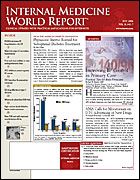Publication
Article
Internal Medicine World Report
Tighter Glucose Control Improves Hospital Outcomes
Author(s):
From the Society of Hospital Medicine
WASHINGTON, DC?Tight glucose control in hospitalized patients can improve outcomes, said Stephen Clement, MD, of Georgetown University Hospital, in his discussion of hyperglycemia in hospitalized patients during the Society of Hospital Medicine annual meeting.
Hyperglycemia is common in hospitalized patients, and it can be associated with a high mortality rate. Patients diagnosed with diabetes have a 3% mortality rate compared with 1.7% in those with normal glucose control. New-onset hyperglycemia increases mortality dramatically, to 16%, in hospitalized patients.
Surgical patients are especially sensitive to even slightly elevated blood sugar levels. Hyperglycemia is associated with increased rates of cadaveric organ rejection in renal transplant recipients and with greater postoperative infection rates in trauma patients.
Postoperative glucose levels <200 mg/dL significantly decrease rejection rates, according to a case-control study of transplant patients. Small increases in glucose can increase rejection rates in the first few days after a transplant.
A study of patients with vascular disorders showed that preoperative glucose levels did not affect outcomes much, but a single postoperative glucose level increase >220 mg/dL led to a considerable rise in infection rates.
The intensive care unit (ICU) patient requires strict control, observed David Lovinger, MD, a hospitalist at the University of Chicago. "Tight glucose control in the surgical ICU reduces mortality," he said.
Dr Clement said that researchers have studied the reasons why high blood glucose leads to poorer outcomes. "Hyperglycemia paradoxically suppresses beta-cell function." Although it is not clear why, glucose levels >150 mg/dL tend to suppress normal feedback mechanisms. "When patients are so stressed that their sugars are 200 mg/dL [on admission], regardless of whether they are diabetic or not, they never recover from this without our intervention," he added.
In critically ill patients, the body sends signals to the liver to indicate that it is in a catabolic state, and this mobilizes alternative fuels. When a patient has tissue injury related to a critical illness, these alternative fuels lead to direct cytotoxicity, including impairment of the normal response to infection. "Neutrophil function is impaired by hyperglycemia," Dr Clement explained.
Patients who are less critically ill also require good glucose monitoring. In the hospitalized patient who is not in the ICU, fasting blood glucose should be <110 mg/dL, and the peak blood glucose should not exceed 180 mg/dL. How do we do this outside of the ICU? "This is the hard part," said Dr Clement.
"We want to try to get rid of the term ?sliding scale,' because that's where the really bad things happen," he explained. Physicians use sliding-scale insulin ranges that they learned in residency, and the lack of standardization makes management challenging for nurses. In addition, the physiologic action of sliding-scale insulin does not control blood glucose well.
Dr Clement's group proposed a new approach to the management of hyperglycemia in the hospitalized patient, focusing on providing patients with a basal insulin dose and then a supplemental dose, as needed. To avoid hypoglycemia, he uses insulin aspart injection (Novolog) instead of regular insulin.
His hospital reviewed many situations in which patients may have fluctuations in serum glucose. "We really got involved with this in our hospital," said Dr Clement. The development of a standardized, mandatory insulin form for his entire hospital decreased the insulin error rate from 35% in 1 year to only 1 error in the next year. "Hospitals are becoming much more glucocentric," he noted. As a result, patient care should improve.





